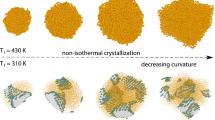Abstract
A diffusion model of the development of concentration heterogeneities of a photopolymerizable composite that takes into account the transition of the monomer-polymer system from the homophase state to the heterophase state with an increase in conversion is proposed. Numerical simulation shows that a significant increase in the amplitude of these heterogeneities is determined not only by the microsyneresis of the composite but also by the efficiency of their development in the homophase state at the initial stage of polymerization. The possibility of controlling the optical properties of the final polymeric material via initiation of the polymerization by radiation of different intensities in the regions of the homophase and heterophase states of the composite is discussed. The numerical-simulation results are experimentally verified.
Similar content being viewed by others
References
J. G. Kloosterboer, Adv. Polym. Sci. 84, 1 (1988).
V. M. Treushnikov and S. A. Chesnokov, J. Photochem. Photobiol. A 196, 201 (2008).
M. A. Baten’kin, S. N. Mensov, and A. V. Romanov, Opt. Zh. 75(5), 34 (2008).
A. I. Levinskii, S. N. Mensov, A. I. D’yachkov, and V. P. Zubov, Vysokomol. Soedin., Ser. B 31, 631 (1989).
G. A. Abakumov, S. N. Mensov, and A. V. Semenov, Opt. Spektrosk. 86, 1029 (1999).
G. A. Abakumov, S. N. Mensov, A. V. Semenov, and S. A. Chesnokov, Polymer Science, Ser. B 42, 180 (2000).
G. A. Abakumov, M. A. Baten’kin, S. N. Mensov, A. V. Romanov, and S. A. Chesnokov, Materialovedenie, No. 11, 39 (2007).
V. I. Irzhak and S. M. Mezhikovskii, Usp. Khim. 77, 79 (2008).
T. I. Izaak and O. V. Vodyankina, Usp. Khim. 78, 80 (2009).
M. A. Baten’kin, A. N. Konev, S. N. Mensov, and S. A. Chesnokov, Polymer Science, Ser. A 53, 558 (2011).
S. N. Mensov and A. V. Romanov, Opt. Spektrosk. 101, 692 (2006).
A. A. Berlin, G. V. Korolev, T. Ya. Kefeli, and Yu. M. Severgin, Acrylic Oligomers and Related Materials (Khimiya, Moscow, 1983) [in Russian].
G. V. Korolev, Usp. Khim. 72, 222 (2003).
A. E. Chalykh, Water Diffusion in Polymer Systems (Khimiya, Moscow, 1987) [in Russian].
J. V. Kelly, M. R. Gleeson, and C. E. Close, Opt. Express 13, 6990 (2005).
S. M. Mezhikovskii and V. I. Irzhak, Chemical Physics of Oligomer Curing (Nauka, Moscow, 2008) [in Russian].
A. A. Berlin, T. Ya. Kefeli, and G. V. Korolev, Polyetheracrylates (Nauka, Moscow, 1967) [in Russian].
S. Wales, Phase Equilibria in Chemical Technology (Mir, Moscow, 1989) [in Russian].
A. A. Tager, Physical Chemistry of Polymers (Khimiya, Moscow, 1968) [in Russian].
R. Lattés and J.-L. Lions, Méthode de quasi-réversibilité et applications (Paris, 1967; Mir, Moscow, 1970).
S. I. Kabanikhin, Reverse and Incorrect Problems (Sib. Nauchn. Izd., Novosibirsk, 2009) [in Russian].
N. N. Kalitkin, Numerical Computation Methods (Nauka, Moscow, 1978) [in Russian].
V. P. Skripov and A. V. Skripov, Usp. Fiz. Nauk 128, 193 (1979).
V. P. Savel’yanov, General Chemical Technology of Polymers (Integralpress, Moscow, 2000) [in Russian].
Plastics Technology, Ed. by V.V. Korshak (Khimiya, Moscow, 1985) [in Russian].
S. A. Chesnokov, V. K. Cherkasov, G. A. Abakumov, O. N. Mamysheva, Yu. V. Chechet, and V. I. Nevodchikov, Izv. Akad. Nauk, Ser. Khim., No. 12, 2258 (2001).
S. D. Khizhnyak, M. N. Malanin, and P. M. Pakhomov, Polymer Science, Ser. B 50, 158 (2008).
Author information
Authors and Affiliations
Corresponding author
Additional information
Original Russian Text © M.A. Baten’kin, S.N. Mensov, 2012, published in Russian in Vysokomolekulyarnye Soedineniya, Ser. B, 2012, Vol. 54, No. 10, pp. 1576–1584.
This work was supported by the Russian Foundation for Basic Research (project nos. 12-03.01092-a, 11-03-12184-ofi-m, and 11-03-97040-p-povolzh’e-a); the Division of Chemistry and Materials Sciences, Russian Academy of Sciences, within the framework of the program of basic research Creation and Study of Macromolecules and Macromolecular Structures of New Generations; and a grant from the president of the Russian Federation (NSh.1113.2012.3).
Rights and permissions
About this article
Cite this article
Baten’kin, M.A., Mensov, S.N. A diffusion model of the development of concentration heterogeneities in a photopolymerizable environment with allowance for the limited compatibility of a monomer and a polymer. Polym. Sci. Ser. B 54, 496–503 (2012). https://doi.org/10.1134/S1560090412100016
Received:
Revised:
Published:
Issue Date:
DOI: https://doi.org/10.1134/S1560090412100016




